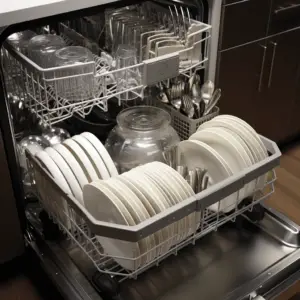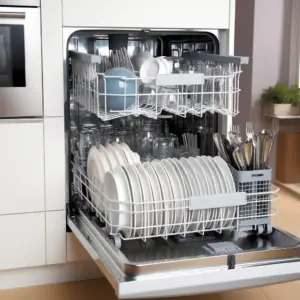GE Dishwasher Not Draining Issues, GE dishwashers are designed to wash dishes and remove wastewater from the washtub at the end of the cycle. If you find that there is more than a cup or two of water remaining in the bottom of the tub, you may have a problem. There are several reasons this could happen, so you will need to troubleshoot the problem to find the cause.
Table of Contents
GE Dishwasher Not Draining: Possible Reasons

One possible reason for this issue is that the drain hose is blocked or not connected properly. Another possibility is that the filter and sump are clogged by debris. If you cannot find the problem, you may need to call a service technician for assistance. Nonetheless, here are a few checks to help fix the drainage issue in your GE dishwasher.
Drain Pipe and Garbage Disposal
Before you check the dishwasher for any potential problems, it’s important to check the pipe that it drains into first to rule out a clog. If your dishwasher is connected to a garbage disposal, clear any debris that may be blocking it.
The garbage disposal’s drain tube that connects to the dishwasher drain hose can also become clogged, so detaching the hose and clearing the tube may resolve the drainage problem. In case the dishwasher was recently installed, ensure that the garbage disposal knockout plug in the tube has been detached.
Air Gap and High Loop
If your dishwasher doesn’t have a garbage disposal, it may be connected to an air gap. And if you don’t have an air gap, the drain hose may be positioned in a high loop underneath your sink. Both the air gap and high loop are designed to stop wastewater from flowing back into the dishwasher during the draining cycle. However, if the drainpipe isn’t in the right position or the air gap is clogged, it could be the reason why your dishwasher isn’t draining properly.
The air gap, in this case, refers to a fitting mounted to the kitchen cabinet or sink. It works by supplying air into the hose, which eradicates the unwanted pressure that can cause the discharged wastewater to get back to the dishwasher. You can remove the cover and cap to check and clean off debris.
With the “high top” method, the drain hose is looped up so that it stays secured just under the sink. Inspect the dishwasher’s manual for the right specifications for your dishwasher’s drain hose.
Fault Drain Hose
Another reason that could keep your dishwasher from draining is a faulty drain hose, which could be kinked or blocked. So, be sure to check if the drain hose is kinked. If it is not, then inspect to see whether the drain hose is blocked. Disconnecting the drain hose from under the sink is not hard at all; just get pliers and use them to release clamps that are securing the drain hose in place, and then use a drain snake tool to clear the hose of debris.
Another way to clear a clogged drain hose is to put the end of the hose into a large bucket and run a short cycle. This may cause the blockage to blow out into the bucket or demonstrate that the pump is not working. Be prepared to turn the dishwasher off or have another bucket handy to collect the discharged water.
Clogged Drain Pump
There are a few things that could be causing your dishwasher to malfunction – one common issue is a faulty drain pump. Pump motors can fail for electrical or mechanical reasons. A mechanical failure is often caused by a broken impeller or something blocking the drain pump.
You can check to see if the impeller on the drain pump is working by manually trying to turn it. If it won’t rotate, then you will probably need to replace the drain pump. If an impeller is damaged, you will need to either replace the impeller or the entire drain pump.
To test whether there’s an electronic problem in the drain pump, get a multimeter and test the drain pump for power continuity. You will need to replace the pump if it fails the continuity test. Remember that most drain pumps are designed to show a reading of around 200 ohms when testing for resistance.
Depending on your specific model, you can access the drain pump by either putting the dishwasher on its back and unscrewing the access panel underneath it or simply removing the bottom-front kick plate. Alternatively, you can access the drain pump by removing the filter inside the dishwasher tub. Remember to shut off the water supply and disconnect the power to the dishwasher before accessing the drain pump.
Clogged Filter and Sump
GE dishwashers with replaceable filters are normally situated at the bottom. That lets you remove the filter and clean the drain pump of particles. Check if the filter is detachable and clean it with warm water and soap. Remove debris too.
The sump assembly basically refers to the dishwasher tub, and its main purpose is to collect water for the pump. You can help the dishwasher to drain and prevent future blockages by making sure the sump area is clean and free of large debris. Again, remember to disconnect the power to the dishwasher before trying to access the filter.
Faulty Drain Solenoid

The drain solenoid is responsible for opening the drain valve in order to allow water to escape the dishwasher. Unfortunately, the solenoid is prone to damage from drastic changes in temperature. If the solenoid is not working, the valve will not open and the dishwasher will not be able to drain.
You can use a multimeter to test the solenoid and see if it has continuity. If it does not, then it needs to be replaced. The solenoid is located by the motor or on the drain pump. You can access it by removing the bottom-front kick plate or bottom access panel.
